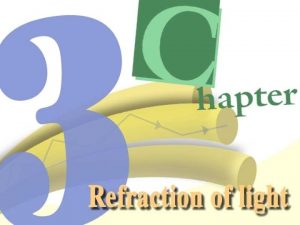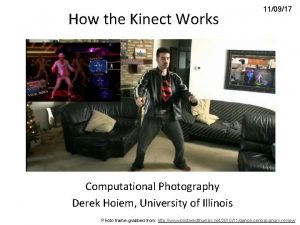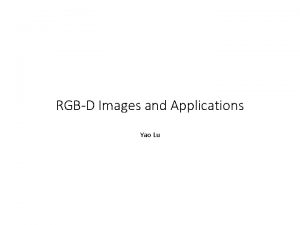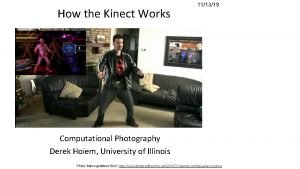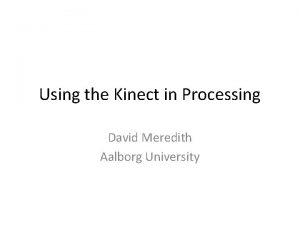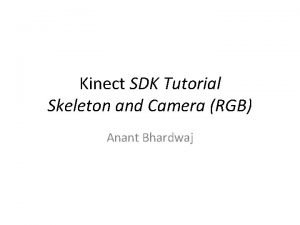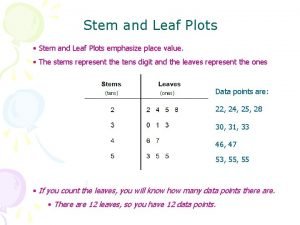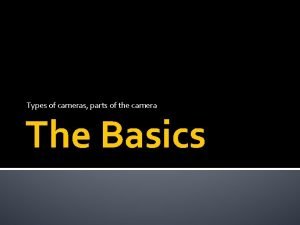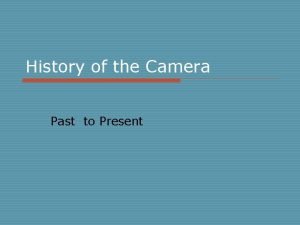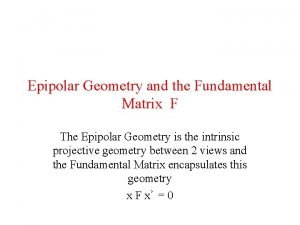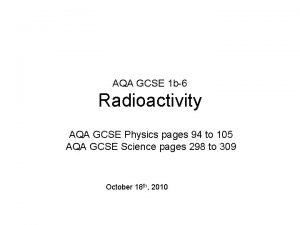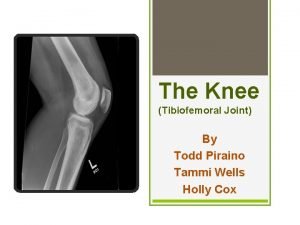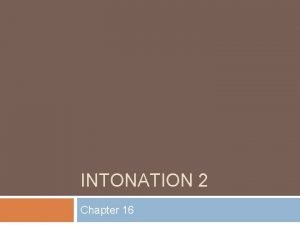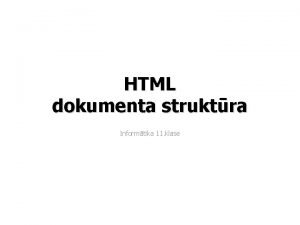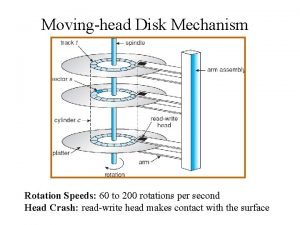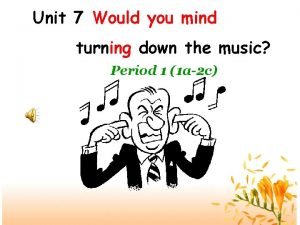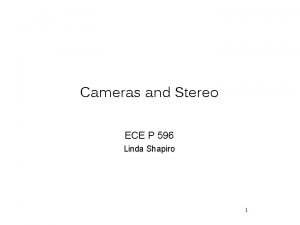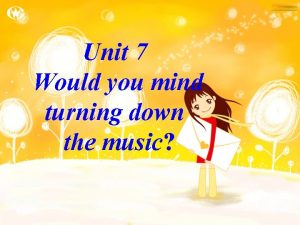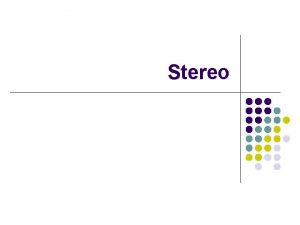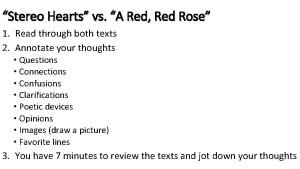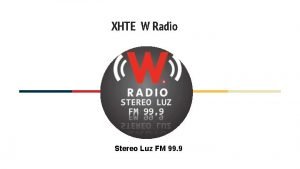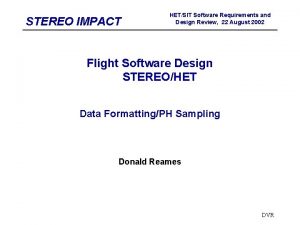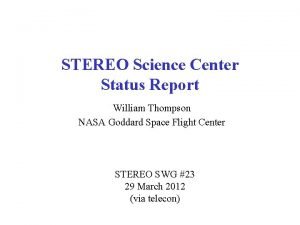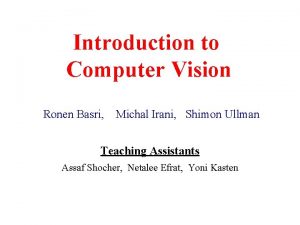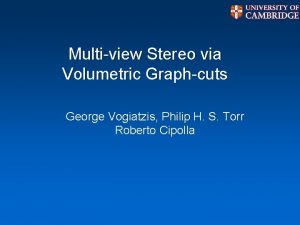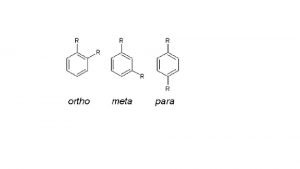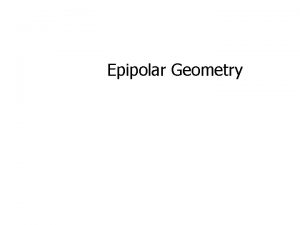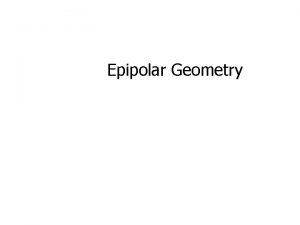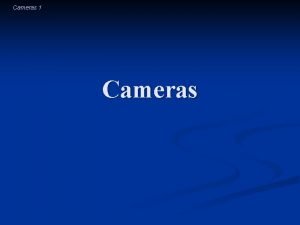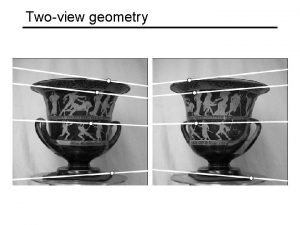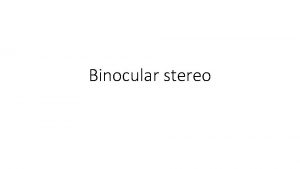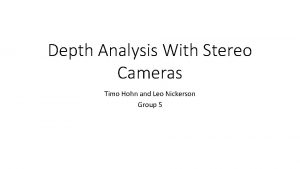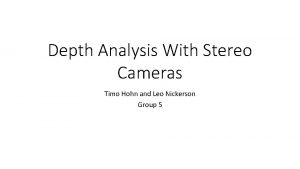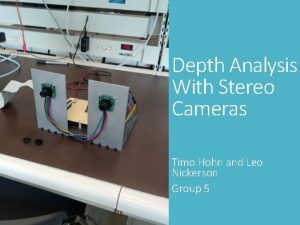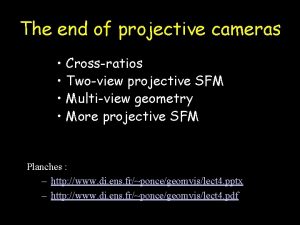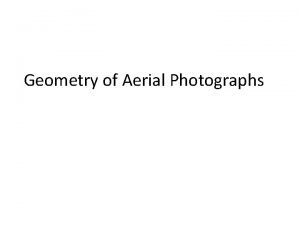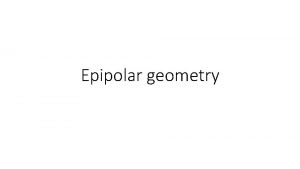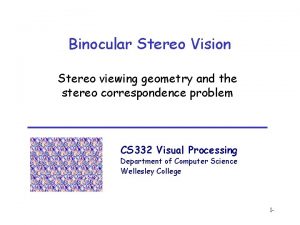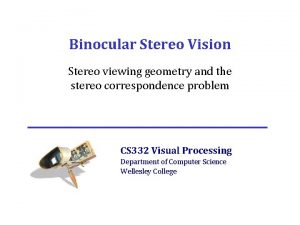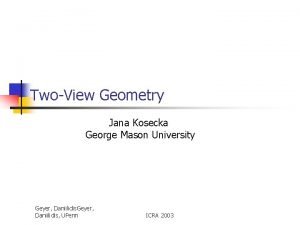Twoview geometry Stereo head Kinect depth cameras Stereo
















































![Essential matrix and epipoles • E = [t]XR • Ep is an epipolar line Essential matrix and epipoles • E = [t]XR • Ep is an epipolar line](https://slidetodoc.com/presentation_image/45e122553ab65511251e76b22361676e/image-49.jpg)
![Essential matrix and epipoles • E = [t]XR • ETq is an epipolar line Essential matrix and epipoles • E = [t]XR • ETq is an epipolar line](https://slidetodoc.com/presentation_image/45e122553ab65511251e76b22361676e/image-50.jpg)
- Slides: 50

Two-view geometry

Stereo head Kinect / depth cameras

Stereo with rectified cameras • Special case: cameras are parallel to each other and translated along X axis Z axis

Perspective projection in rectified cameras • Without loss of generality, assume origin is at pinhole of 1 st camera

Perspective projection in rectified cameras • Without loss of generality, assume origin is at pinhole of 1 st camera X coordinate differs by tx/Z Y coordinate is the same!

Perspective projection in rectified cameras • disparity = tx/Z • If tx is known, disparity gives Z • Otherwise, disparity gives Z in units of tx • Small-baseline, near depth = large-baseline, far depth

Perspective projection in rectified cameras • For rectified cameras, correspondence problem is easier • Only requires searching along a particular row.

Rectifying cameras • Given two images from two cameras with known relationship, can we rectify them?

Rectifying cameras • Can we rotate / translate cameras? • Do we need to know the 3 D structure of the world to do this?

Rotating cameras • Assume K is identity • Assume coordinate system at camera pinhole

Rotating cameras • Assume K is identity • Assume coordinate system at camera pinhole

Rotating cameras • What happens if the camera is rotated?

Rotating cameras • What happens if the camera is rotated? Rotation matrix Homogenous coordinates of mapped pixel Homogenous coordinates of original pixel • No need to know the 3 D structure

Rotating cameras

Rectifying cameras

Rectifying cameras

Rectifying cameras

Rectifying cameras

Perspective projection in rectified cameras • For rectified cameras, correspondence problem is easier • Only requires searching along a particular row.

Perspective projection in rectified cameras What about nonrectified cameras? Is there an equivalent? • For rectified cameras, correspondence problem is easier • Only requires searching along a particular row.

Epipolar constraint • Reduces 2 D search problem to search along a particular line: epipolar line

Epipolar constraint True in general! • Given pixel (x, y) in one image, corresponding pixel in the other image must lie on a line • Line function of (x, y) and parameters of camera • These lines are called epipolar line

Epipolar geometry

Epipolar geometry - why? • For a single camera, pixel in image plane must correspond to point somewhere along a ray

Epipolar geometry • When viewed in second image, this ray looks like a line: epipolar line • The epipolar line must pass through image of the first camera in the second image - epipole Epipolar line

Epipolar geometry Given an image point in one view, where is the corresponding point in the other view? ? epipolar line C / C epipole baseline • A point in one view “generates” an epipolar line in the other view • The corresponding point lies on this line

Epipolar line Epipolar constraint • Reduces correspondence problem to 1 D search along an epipolar line

Epipolar lines

Epipolar lines

Epipolar lines Epipole

Epipolar geometry continued Epipolar geometry is a consequence of the coplanarity of the camera centres and scene point X x C x/ C/ The camera centres, corresponding points and scene point lie in a single plane, known as the epipolar plane

Nomenclature X left epipolar line l/ x right epipolar line x/ e e/ C C/ • The epipolar line l/ is the image of the ray through x • The epipole e is the point of intersection of the line joining the camera centres with the image plane this line is the baseline for a stereo rig, and the translation vector for a moving camera • The epipole is the image of the centre of the other camera: e = PC/ , e/ = P/C

The epipolar pencil X e e / baseline As the position of the 3 D point X varies, the epipolar planes “rotate” about the baseline. This family of planes is known as an epipolar pencil (a pencil is a one parameter family). All epipolar lines intersect at the epipole.

The epipolar pencil X e e / baseline As the position of the 3 D point X varies, the epipolar planes “rotate” about the baseline. This family of planes is known as an epipolar pencil (a pencil is a one parameter family). All epipolar lines intersect at the epipole.

Epipolar geometry - the math • Assume intrinsic parameters K are identity • Assume world coordinate system is centered at 1 st camera pinhole with Z along viewing direction

Epipolar geometry - the math • Assume intrinsic parameters K are identity • Assume world coordinate system is centered at 1 st camera pinhole with Z along viewing direction

Epipolar geometry - the math • Assume intrinsic parameters K are identity • Assume world coordinate system is centered at 1 st camera pinhole with Z along viewing direction

Epipolar geometry - the math • Assume intrinsic parameters K are identity • Assume world coordinate system is centered at 1 st camera pinhole with Z along viewing direction

Epipolar geometry - the math • Assume intrinsic parameters K are identity • Assume world coordinate system is centered at 1 st camera pinhole with Z along viewing direction

Epipolar geometry - the math 0 0

Epipolar geometry - the math • Can we write this as matrix vector operations? • Cross product can be written as a matrix

Epipolar geometry - the math • Can we write this as matrix vector operations? • Dot product can be written as a vector-vector times

Epipolar geometry - the math • Can we write this as matrix vector operations? • Dot product can be written as a vector-vector times

Epipolar geometry - the math

Epipolar geometry - the math Homogenous coordinates of point in image 2 point in image 1 Essential matrix

Epipolar constraint and epipolar lines • Consider a known, fixed pixel in the first image • What constraint does this place on the corresponding pixel? • where • What kind of equation is this?

Epipolar constraint and epipolar lines • Consider a known, fixed pixel in the first image • where Line!

Epipolar constraint: putting it all together • If p is a pixel in first image and q is the corresponding pixel in the second image, then: q. TEp = 0 • E = [t]XR • For fixed p, q must satisfy: Epipolar line in 2 nd image q. Tl = 0, where l = Ep • For fixed q, p must satisfy: Epipolar line in 1 st image l. Tp = 0 where l. T = q. TE, or l = Etq • These are epipolar lines!
![Essential matrix and epipoles E tXR Ep is an epipolar line Essential matrix and epipoles • E = [t]XR • Ep is an epipolar line](https://slidetodoc.com/presentation_image/45e122553ab65511251e76b22361676e/image-49.jpg)
Essential matrix and epipoles • E = [t]XR • Ep is an epipolar line in 2 nd image • All epipolar lines in second image pass through c 2 • c 2 is epipole in 2 nd image
![Essential matrix and epipoles E tXR ETq is an epipolar line Essential matrix and epipoles • E = [t]XR • ETq is an epipolar line](https://slidetodoc.com/presentation_image/45e122553ab65511251e76b22361676e/image-50.jpg)
Essential matrix and epipoles • E = [t]XR • ETq is an epipolar line in 1 st image • All epipolar lines in first image pass through c 1 • c 1 is the epipole in 1 st image
 Total internal reflection in a semicircular glass block
Total internal reflection in a semicircular glass block Language
Language Skeleton kinect
Skeleton kinect Depth from disparity
Depth from disparity Kinect 原理
Kinect 原理 Kinect toolkit
Kinect toolkit Kinect
Kinect Kinect for windows runtime
Kinect for windows runtime Kinect programming
Kinect programming Processing kinect
Processing kinect Skeleton hand
Skeleton hand Hole in the wall kinect
Hole in the wall kinect Stem and leaf graph
Stem and leaf graph Cameras parts
Cameras parts Jacobs cameras
Jacobs cameras History of the camcorder
History of the camcorder Essential matrix
Essential matrix Speed detection of moving vehicle
Speed detection of moving vehicle Ionising radiation bbc bitesize
Ionising radiation bbc bitesize Lewis structure for pf3
Lewis structure for pf3 Electron domain geometry vs molecular geometry
Electron domain geometry vs molecular geometry The basis of the vsepr model of molecular bonding is
The basis of the vsepr model of molecular bonding is Innervation of biceps femoris short head
Innervation of biceps femoris short head How to use dividing head
How to use dividing head Chest parts
Chest parts The attacking firm goes head-to-head with its competitor.
The attacking firm goes head-to-head with its competitor. 7 tones
7 tones Pre-head head tonic syllable tail
Pre-head head tonic syllable tail Informtika
Informtika The head of moving head disk with 100 tracks
The head of moving head disk with 100 tracks Flooded suction pump
Flooded suction pump Operation of moving head disk storage
Operation of moving head disk storage Similes in stereo hearts
Similes in stereo hearts Would you mind not talking in the library
Would you mind not talking in the library Tcp stereo
Tcp stereo Stereo
Stereo Stereo
Stereo Would you mind ____ the window?
Would you mind ____ the window? Singular e plural
Singular e plural Fusion stereo problems
Fusion stereo problems Stereo hearts simile
Stereo hearts simile Stereo luz fm tehuacan
Stereo luz fm tehuacan Hetsit
Hetsit Stereo hearts rhyme scheme
Stereo hearts rhyme scheme Would you mind turning off the tv
Would you mind turning off the tv Stereo science center
Stereo science center Spiegelbeeld isomerie
Spiegelbeeld isomerie Ronen basri
Ronen basri Multiview stereo
Multiview stereo Konformaatioisomeria
Konformaatioisomeria Photometric stereo
Photometric stereo
